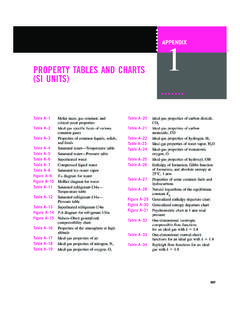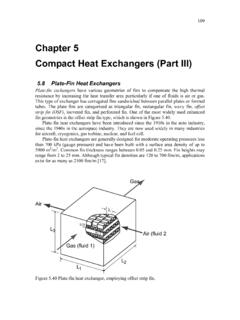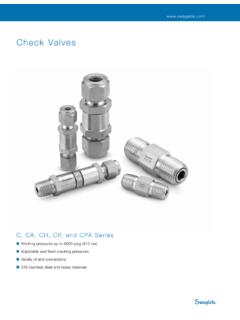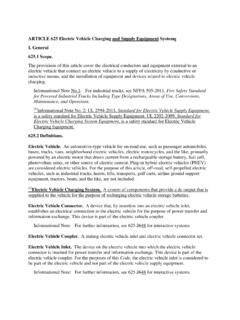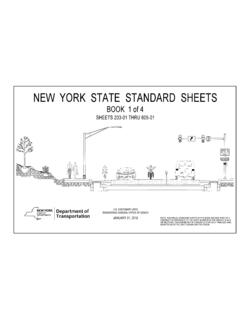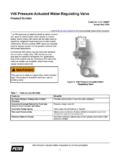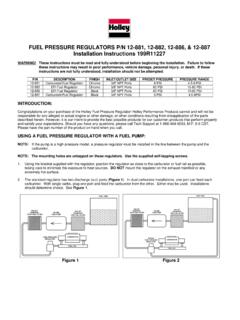Transcription of 5.1 Shell-and-Tube Heat Exchangers
1 Shell-and-Tube Heat Exchangers The most common type of heat exchanger in industrial applications is Shell-and-Tube heat Exchangers . The Exchangers exhibit more than 65% of the market share with a variety of design experiences of about 100 years. Shell-and tube heat Exchangers provide typically the surface area density ranging from 50 to 500 m2/m3 and are easily cleaned. The design codes and standards are available in the TEMA (1999)-Tubular Exchanger Manufacturers Association. A simple exchanger, which involves one shell and one pass, is shown in Figure Shell inletShell outletTube inletTube outletBafflesEndchannelTubeShellShell sheet Figure Schematic of one-shell one-pass (1-1) Shell-and-Tube heat exchanger. Baffles In Figure , baffles are placed within the shell of the heat exchanger firstly to support the tubes, preventing tube vibration and sagging, and secondly to direct the flow to have a higher heat transfer coefficient.
2 The distance between two baffles is baffle spacing. Multiple Passes Shell-and-Tube heat Exchangers can have multiple passes, such as 1-1, 1-2, 1-4, 1-6, and 1-8 Exchangers , where the first number denotes the number of the shells and the second number denotes the number of passes. An odd number of tube passes is seldom used except the 1-1 exchanger. A 1-2 Shell-and-Tube heat exchanger is illustrated in Figure 42 Shell inletShell outletTube inletTube outletBafflesEndchannelPasspartitionTube Shell Figure Schematic of one-shell two-pass (1-2) Shell-and-Tube heat exchanger. LtDsB Figure Dimensions of 1-1 Shell-and-Tube heat exchanger Dimensions of Shell and Tube Heat Exchanger Some of the following dimensions are pictured in Figure L = tube length tN = number of tube pN = number of pass sD = Shell inside diameter bN = number of baffle B = baffle spacing The baffle spacing is obtained 1+=btNLB ( ) 43 Shell Side Tube Layout Figure shows a cross section of both a square and triangular pitch layouts.
3 The tube pitch tP and the clearance tC between adjacent tubes are both defined. Equation ( ) of the equivalent diameter is rewritten here for convenience heatedcePAD4= ( ) From Figure , the equivalent diameter for the square pitch layout is ()ooteddPD 4422 = ( ) From Figure , the equivalent diameter for the triangular pitch layout is 2843422ooteddPD = ( ) The cross flow area of the shell cA is defined as TtscPBCDA= ( ) PtdidoFlowPt(a)(b)dodiCtCt Figure (a) Square-pitch layout, (b) triangular-pitch layout. The diameter ratio dr is defined by iorddd= ( ) Some diameter ratios for nominal pipe sizes are illustrated in Table in Appendix C. The tube pitch ratio Pr is defined by 44 otrdPP= ( ) The tube clearance Ct is obtained from Figure ottdPC = ( ) The number of tube Nt can be predicted in fair approximation with the shell inside diameter Ds. ()ShadeAreaDCTPNst42 = ( ) where CTP is the tube count constant that accounts for the incomplete coverage of the shell diameter by the tubes, due to necessary clearance between the shell and the outer tube circle and tube omissions due to tube pass lanes for multiple pass design [1].
4 CTP = for one-pass exchanger CTP = for two-pass exchanger ( ) CTP = for three-pass exchanger 2tPCLS hadeArea = ( ) where CL is the tube layout constant. CL = 1 for square-pitch layout ( ) CL = sin(60 ) = for triangular-pitch layout Plugging Equation ( ) into ( ) gives 2222244orststdPDCLCTPPDCLCTPN = = ( ) Table Summary of Shell-and-Tube heat Exchangers Description Equation Basic Equations ()oipTTcmq1111 =& ( ) ()iopTTcmq2222 =& ( ) Heat transfer areas of the inner and outer surfaces of an inner pipe LNdAtii = LNdAtoo = ( ) ( ) 45 Overall Heat Transfer Coefficient ooioiiooAhkLddAhAU12ln11+ += ( ) Tube side Reynolds number ciimDAdmdu&==Re pticNNdA42 = ( ) ( ) Laminar flow (Re < 2300) ==sifiDLdkhdNu < Pr < 16,700 < ()s < if <DNu ( ) Turbulent flow (Re > 2300) Friction factor ()()()()1Pr2 + ==ffkhdNuDfiD 6105Re3000 <<D[4] ()() =Df ( ) ( ) Shell side Square pitch layout (Figure ) ()ooteddPD 4422 = ( )
5 Triangular pitch layout (Figure ) 2843422ooteddPD = ( ) Cross flow area ttscPBCDA= ( ) Reynolds number ceemDADmDu&==Re ( ) 46 Nusselt number ==sfeokDhNu 2000 <Re < 1 x 106 ( ) NTU Method Heat transfer unit (NTU) ()minpoocmAUNTU&= ( ) Capacity ratio ()()maxminpprcmcmC&&= ( ) Effectiveness One shell (2, 4,.. passes) ()()[]()[]212121212121exp11exp1112 + + ++++=rrrrCNTUCNTUCC pNNTUNTU=1 ( ) Heat transfer unit (NTU) () + + = 11ln1212 EECNTUr where ()()212112rrCCE++ = ( ) Effectiveness ()()()()()()()()iipiopiipoipTTcmTTcmTTcm TTcmqq21min222221min1111max = ==&&&& ( ) Heat transfer rate ()()iipTTcmq21min =& ( ) Tube Side Pressure Drop Pressure drop 2v2114 + = pitNdLfP ( ) Laminar flow DfRe16= ( ) Turbulent flow ()() =Df ( ) Shell Side Pressure Drop 47 ()2v211 += besNDDfP ()() = ( ) ( ) 48 Example Miniature Shell-and-Tube Heat Exchanger A miniature Shell-and-Tube heat exchanger is designed to cool engine oil in an engine with the engine coolant (50% ethylene glycol).
6 The engine oil at a flow rate of kg/s enters the exchanger at 120 C and leaves at 115 C. The 50% ethylene glycol at a rate of kg/s enters at 90 C. The tube material is Cr alloy (kw = W/mK). Fouling factors of m2K/W for engine oil and m2K/W for 50% ethylene glycol are specified. Route the engine oil through the tubes. The permissible maximum pressure drop on each side is 10 kPa. The volume of the exchanger is required to be minimized. Since the exchanger is custom designed, the tube size can be smaller than NPS 1/8 (DN 6 mm) that is the smallest size in Table in Appendix C, wherein the tube pitch ratio of and the diameter ratio of can be applied. Design the Shell-and-Tube heat exchanger. Figure Shell and tube heat exchanger MathCAD format solution: Design concept is to develop a MathCAD modeling for a miniature Shell-and-Tube heat exchanger and then seek the solution by iterating the calculations by varying the parameters to satisfy the design requirements.
7 It is reminded that the design requirements are the engine oil outlet temperature less than 115 C and the pressure drop less than 10 kPa in each side of the fluids. The properties of engine oil and ethylene glycol are obtained using the average temperatures from Table in Appendix C. Toil120 C 115 C+() C =:=Tcool90 C 100 C+()295 C =:= ( ) 49 Engine oil (subscript 1)-tube side50% Ethylene glycol (subscript 2)-shell side 1828kgm3:= 21020kgm3:= ( ) cp12307 Jkg K :=cp23650 Jkg K := K := K := N s m2:= 102 N s m2:= Pr1175:= := The thermal conductivity for the tube material (Chromium alloy) is given K := ( ) Given information: The inlet temperatures are given as T1i120 C:=T2i90 C:= ( ) The mass flow rates are given as := := ( ) The fouling factors for engine oil and 50% ethylene glycol are given as m2K W:= m2K W:= ( ) Design requirement: The engine oil outlet temperature must be less than 115 C.
8 T1o115 C ( ) The pressure drop on each side must be P 10kPa ( ) 50 Design parameters to be sought by iterations Initially, estimate the following boxed parameters and then iterate the calculations with different values toward the design requirements. :=Shell inside ( ) Lt15in:=Tube lengthLt381mm= ( ) do18in:=Tube outside = ( ) The diameter ratio (dr = do/di) is given as suggested in the problem description. :=di1drdo := = ( ) The tube pitch ratio (Pr = Pt/do) is given as suggested in the problem description. := ( ) The tube pitch is then obtained from Equation ( ). PtPrdo := ( ) The baffle spacing is assumed and may be iterated, and the baffle number from Equation ( ) is defined. B88in:=B ( ) NbLtB1 :=Nb14= ( ) The number of passes is defined by Np1:= ( ) The tube clearance Ct is obtained from Figure as CtPtdo := = ( ) 51 From Equation ( ), the tube count calculation constants (CTP) up to three-passes are given otherwise:= ( ) From Equation ( ), the tube layout constant (CL) for a triangular-pitch layout is given by CL := ( ) The number of tubes Nt is estimated using Equation ( ) and rounded off in practice.
9 Note that the number of tubes in the shell inside diameter defined earlier indicates the compactness of a miniature exchanger. A 253-tube exchanger in a shell outside diameter is commercially available for a 2-inch shell diameter. NtubeDsdo, Pr, () 4 CTPCL Ds2Pr2do2 :=NtubeDsdo, Pr, () ( ) Ntround NtubeDsdo, Pr, ()():=Nt138= ( ) Tube side (Engine oil) The crossflow area, velocity and Reynolds number are defined as Ac1 di2 4 NtNp := 104 m2= ( ) v1mdot1 1Ac1 := ( ) Re1 1v1 di 1:= ( ) The Reynolds number indicates very laminar flow. The velocity in the tubes appears acceptable when considering a reasonable range of m/s in Table for the engine oil. 52 The friction factor is determined automatically whether it is either laminar or turbulent using the following program as f ReD() ln ReD() ()2 ReD2300>if16 ReDotherwise:= ( ) The Nusselt number for turbulent or laminar flow is defined using Equations ( ) and ( ) with assuming that changes moderately with temperature.
10 The convection heat transfer coefficient is then obtained. NuDDhLt, ReD, Pr, ()f ReD()2 ReD1000 ()Pr 1 ReD()2 Pr231 + ReD2300> Pr Lt 13 otherwise:= ( ) Nu1 NuDdiLt, Re1, Pr1, ():= ( ) h1Nu1k1 di:= = ( ) Shell side (50% ethylene glycol) The free-flow area is obtained using Equation ( ) and the velocity in the shell is also calculated Ac2 DsCt B Pt:= 104 m2= ( ) v2mdot2 2Ac2 := ( ) 53 The velocity of m/s in the shell is acceptable because the reasonable range of m/s for the similar fluid shows in Table The equivalent diameter for a triangular pitch is given in Equation ( ) as De4Pt23 4 do2 8 do 2 := = ( ) Re2 2v2 De 2:= 103 = ( ) The Nusselt number is given in Equation ( ) and the heat transfer coefficient is obtained. Pr213 := ( ) h2Nu2k2 De:= 104 Wm2K = ( ) The total heat transfer areas for both fluids are obtained as Ai di Lt Nt := ( ) Ao do Lt Nt := = ( ) The overall heat transfer coefficient is calculated using Equation ( ) with the fouling factors as Uo1Ao1h1Ai RfiAi+lndodi 2 kw Lt +RfoAo+1h2Ao +:= = ( ) 54 NTU method The heat capacities for both fluids are defined and then the minimum and maximum heat capacities are obtained using the MathCAD built-in functions as C1mdot1cp1 := = ( ) C2mdot2cp2 := 103 WK = ( ) Cminmin C1C2, ():=Cmaxmax C1C2, ():= ( ) The heat capacity ratio is defined as CrCminCmax:= ( ) The number of transfer unit is defined as NTUUoAo Cmin:=NTU ( ) The effectiveness for Shell-and-Tube heat exchanger is give using Equation ( ) as NTU1 NTUNp:= ( ) hx2 1 Cr+1 Cr2+ exp NTU1 1 Cr2+ +1 exp NTU1 1 Cr2+ + 1.


